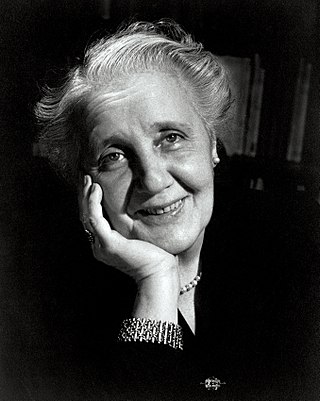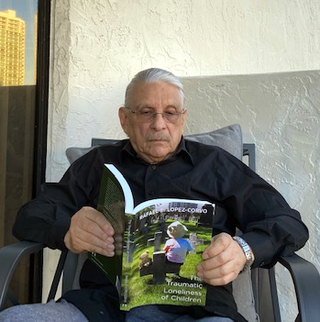
In psychology, fantasy is a broad range of mental experiences, mediated by the faculty of imagination in the human brain, and marked by an expression of certain desires through vivid mental imagery. Fantasies are generally associated with scenarios that are impossible or unlikely to happen.

Melanie Klein was an Austrian-British author and psychoanalyst known for her work in child analysis. She was the primary figure in the development of object relations theory. Klein suggested that pre-verbal existential anxiety in infancy catalyzed the formation of the unconscious, which resulted in the unconscious splitting of the world into good and bad idealizations. In her theory, how the child resolves that split depends on the constitution of the child and the character of nurturing the child experiences. The quality of resolution can inform the presence, absence, and/or type of distresses a person experiences later in life.

Civilization and Its Discontents is a book by Sigmund Freud, the founder of psychoanalysis. It was written in 1929 and first published in German in 1930 as Das Unbehagen in der Kultur. Exploring what Freud sees as the important clash between the desire for individuality and the expectations of society, the book is considered one of Freud's most important and widely read works, and was described in 1989 by historian Peter Gay as one of the most influential and studied books in the field of modern psychology.
Object relations theory is a school of thought in psychoanalytic theory and psychoanalysis centered around theories of stages of ego development. Its concerns include the relation of the psyche to others in childhood and the exploration of relationships between external people, as well as internal images and the relations found in them. Thinkers of the school maintain that the infant's relationship with the mother primarily determines the formation of its personality in adult life. Particularly, attachment is the bedrock of the development of the self or the psychic organization that creates the sense of identity.

Otto Friedmann Kernberg is an Austrian-born American psychoanalyst and professor of psychiatry at Weill Cornell Medicine. He is most widely known for his psychoanalytic theories on borderline personality organization and narcissistic pathology. In addition, his work has been central in integrating postwar ego psychology with Kleinian and other object relations perspectives. His integrative writings were central to the development of modern object relations, a school within modern psychoanalysis.
In Freudian Ego psychology, psychosexual development is a central element of the psychoanalytic sexual drive theory. Freud believed that personality developed through a series of childhood stages in which pleasure seeking energies from the child became focused on certain erogenous areas. An erogenous zone is characterized as an area of the body that is particularly sensitive to stimulation. The five psychosexual stages are the oral, the anal, the phallic, the latent, and the genital. The erogenous zone associated with each stage serves as a source of pleasure. Being unsatisfied at any particular stage can result in fixation. On the other hand, being satisfied can result in a healthy personality. Sigmund Freud proposed that if the child experienced frustration at any of the psychosexual developmental stages, they would experience anxiety that would persist into adulthood as a neurosis, a functional mental disorder.
In development psychology, Melanie Klein proposed a "(psychic) position theory" instead of a "(psychic) stage theory".

William Ronald Dodds Fairbairn FRSE was a Scottish psychiatrist, psychoanalyst and a central figure in the development of the Object Relations Theory of psychoanalysis. He was generally known and referred to as "W. Ronald D. Fairbairn".
In classical Freudian psychoanalytic theory, the death drive is the drive toward death and destruction, often expressed through behaviors such as aggression, repetition compulsion, and self-destructiveness. It was originally proposed by Sabina Spielrein in her paper "Destruction as the Cause of Coming Into Being" in 1912, which was then taken up by Sigmund Freud in 1920 in Beyond the Pleasure Principle. This concept has been translated as "opposition between the ego or death instincts and the sexual or life instincts". In Beyond thePleasure Principle, Freud used the plural "death drives" (Todestriebe) much more frequently than the singular.
Projective identification is a term introduced by Melanie Klein and then widely adopted in psychoanalytic psychotherapy. Projective identification may be used as a type of defense, a means of communicating, a primitive form of relationship, or a route to psychological change; used for ridding the self of unwanted parts or for controlling the other's body and mind.

The Ego and the Id is a prominent paper by Sigmund Freud, the founder of psychoanalysis. It is an analytical study of the human psyche outlining his theories of the psychodynamics of the id, ego and super-ego, which is of fundamental importance in the development of psychoanalysis. The study was conducted over years of research and was first published in the third week of April 1923.
Splitting is the failure in a person's thinking to bring together the dichotomy of both perceived positive and negative qualities of something into a cohesive, realistic whole. It is a common defense mechanism wherein the individual tends to think in extremes. This kind of dichotomous interpretation is contrasted by an acknowledgement of certain nuances known as "shades of gray".
Love and hate as co-existing forces have been thoroughly explored within the literature of psychoanalysis, building on awareness of their co-existence in Western culture reaching back to the “odi et amo” of Catullus, and Plato's Symposium.
Donald Meltzer (1922–2004) was a Kleinian psychoanalyst whose teaching made him influential in many countries. He became known for making clinical headway with difficult childhood conditions such as autism, and also for his theoretical innovations and developments. His focus on the role of emotionality and aesthetics in promoting mental health has led to his being considered a key figure in the "post-Kleinian" movement associated with the psychoanalytic theory of thinking created by Wilfred Bion.

Rafael E. Lopez-Corvo is a Venezuelan-born medical doctor, psychiatrist and psychoanalyst. He is a former associate professor at Ottawa and McGill Universities and Program Director of Child and Adolescents Unite at the Douglas Hospital, McGill University in Montreal, Canada. He was also a member of the editorial board of the International Journal of Psycho-Analysis for Latin-America. Likewise, he is a training and supervising psychoanalyst for the International Psychoanalytic Association as well as the Canadian, Venezuelan and American Psychoanalytic Societies.
In psychoanalysis, the primal scene is the theory of the initial unconscious fantasy of a child of a sex act, between the parents, that organises the psychosexual development of that child.
John Steiner is a psychoanalyst, author and trainer at the British Psychoanalytical Society. Steiner, a "prolific London post-Kleinian", is best known for his conceptions of the "pathological organisation" or the "psychic retreat"...between the paranoid-schizoid and the depressive positions'. His book, Psychic Retreats, describes a treatment methodology for patients with complex defence mechanisms that are difficult to treat with conventional psychoanalysis.
The term reparation was used by Melanie Klein (1921) to indicate a psychological process of making mental repairs to a damaged internal world. In object relations theory, it represents a key part of the movement from the paranoid-schizoid position to the depressive position — the pain of the latter helping to fuel the urge to reparation.
Paranoid anxiety is a term used in object relations theory, particularity in discussions about the Paranoid-schizoid and depressive positions. The term was frequently used by Melanie Klein, especially to refer to a pre-depressive and persecutory sense of anxiety characterised by the psychological splitting of objects.
Depressive anxiety is a term developed in relation to the depressive position by Melanie Klein, building on Freud's seminal article on object relations of 1917, 'Mourning and Melancholia'. Depressive anxiety revolved around a felt state of inner danger produced by the fear of having harmed good internal objects - as opposed to the persecutory fear of ego annihilation more typical of paranoid anxiety.